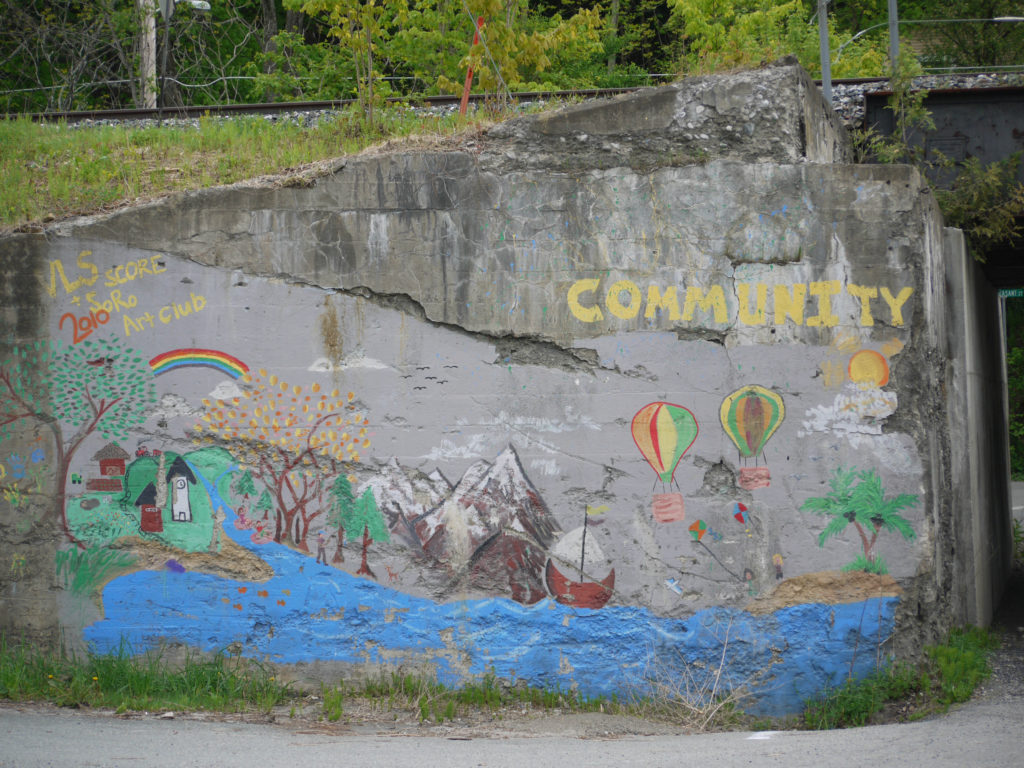A team of researchers from Yale, NYU and Washington State University recently published research in the Journal of Community Psychology investigating how to foster community connections among those with mental health diagnoses. To accomplish this, the researchers conducted focus groups with 20 grassroots community leaders and examined the social and structural factors that impact community engagement in mental health service-users. The group identified what they believed facilitated or hindered community connection and made suggestions as to how to overcome stigma and improve connectedness and integration.
“In order for community groups to develop the welcoming atmosphere cited by several participants as integral to community connections,” write the authors, “communities require support as they shift from being made weary by accommodating people who are perceived as different to having the capacity to welcoming and engaging them to, finally, benefiting from their contributions.”

Thanks to the community mental health and recovery fields, there has been a shift toward perceiving people with mental health diagnoses as being capable of living meaningful lives in their community. Similarly, the citizenship movement encourages civic participation and full inclusion of people diagnosed with mental disorders, which benefits both the individuals themselves and society as a whole.
Still, mental health service-users face a variety of structural barriers to full integration in the community which can contribute to a variety of poor health outcomes. For example, social connectedness/support have been shown to have a significant relationship with mental and physical health, while marginalization and weak social support are significantly related to mortality. Often, social isolation has been shown to be associated with institutionalization, incarceration, and homelessness, which serve as excuses to exclude such individuals from communities.
“Negative attitudes toward mental illnesses further compound this marginalization and can result in lost opportunities for employment, education, housing, and access to healthcare and other community resources,” write the authors. “As a result, individuals with mental illnesses disproportionately experience poverty, unemployment, homelessness, and unsafe housing and face structural and societal stigma.”
Leaders in the field of community psychology have been increasingly vocal about re-engaging with mental health service users with supportive and inclusive environments. One such route to increasing this engagement would be through community integration. Simply living in a community and physically being in a community space is often not enough to provide a sense of community, safety, stability or belonging. Rather, psychological integration and a psycho-social sense of community are necessary to truly integrate into a community.
The citizenship framework, meanwhile, centers around five R’s: the rights, roles, and resources that are afforded to individuals, the responsibilities an individual assumes and the relationships one forms in the community. A sixth component, sense of belonging, was recently added. The framework exists as a dialectic, such that citizens have both an obligation to engage in the community as well as benefits afforded to them by the community and its surrounding structures.
The focus of the citizenship framework has mostly surrounded the larger sociopolitical context proximate to the individual, rather than consulting individual voices in the community. Ignoring such individuals deprives the field of some of the most knowledgeable voices available, however.
In response, the current study attempted to compile community perspectives on the barriers and enablers of community connections, so as to understand what relationships and belonging look like for individuals diagnosed with mental health issues. To accomplish this goal, a community collaborative composed of mental health service-users, Yale researchers, community organizers, and service providers in the community mental health system was created. 20 such individuals were recruited via a convenience sample, though a diversity of community roles was a focus of recruitment.
Participants ranged from an Episcopalian priest to family services workers and public-school teachers. From these individuals, four focus groups were created, and their conversations were analyzed via inductive thematic analysis. From the analysis, two major themes emerged: what facilitates and what impedes connection, each of which had multiple subgroups.
There were four subgroups for what facilitated connection to a community. First, participants noted the importance of a community ethos, or the atmosphere a community created. This could range from an empowering energy that the community emanated to a shared mindset of support for all members. The second subgroup identified was the creation of valued roles for all community members.
“Another thing that’s really important is people feeling like their presence will be important or like them being there matters in some way,” said one participant. “So, it’s not just like, oh, is this interesting to you, but it’s meaningful that you’re there and for whatever form that takes. Like you’re contributing something. We need you to bring the salad. Even just giving someone a task can be important but in an organizational setting, like you can contribute something to this larger thing.”
Third, personal invitations were seen as valuable to fostering the requisite personal connections present in cohesive communities. Not only do personal invitations draw people in, but they allow specific community members to be targeted, whether that be for their skills or because they’re generally excluded from the community. Further, a personal invitation is more informative than a flyer or social media event. Finally, participants noted that the availability of information was important in facilitating a connection to the community. This, too, was seen to be reciprocal in nature, as community members have a responsibility both to spread the word and seek it out.
As for what impedes connection, participants noted that accessibility was an important factor. Structural barriers such as lack of transportation, language differences, or financial constraints all inhibited connection to a community. In addition to serving as a facilitator of connection, when it is poorly disseminated, information can serve as a barrier to connection. In conjunction with other structural barriers, lack of information often serves to make community connection feel out of reach.
The participants also suggested that stigma plays a role in the lack of community inclusion as those seeking mental health services are often perceived as scary and in need of management and control so as to avoid exposing other community members to discomfort. Participants viewed accommodations for physical disability as easier than managing psycho-social disabilities, as physical illness necessitates only tangible accommodations such as ramps or elevators.
“It’s kind of easier to get your head around [accommodating persons with physical disabilities],” said one participant. “You can build a ramp, you can do whatever, these kind of pragmatic ways. Mental health, it’s exhausting to kind of get your head around. You can’t really, in my experience, you can’t really fix it. It’s … not a quick fix type of thing, and that makes it very difficult.”
Participants also noted that places frequented by mental health service-users are quickly labeled and in turn stigmatized. This raises concerns about whether integration into the community will lead to similar process of labeling and stigmatizing. Even if a community makes an effort to create a space and welcome individuals seeking mental health services, the community members may still hold negative views and stigma against such individuals, viewing their presence as a burden or intrusion.
Some participants felt that this unduly burdened the community, who were inconvenienced by a need to “manage” these new community members, unveiling dangerous assumptions that people with mental health diagnoses don’t have the right to be in the community unless accompanied by someone to “manage” them, and that the community does not have an obligation to welcome and accommodate anyone who wishes to join them.
For change to occur, communities must not merely accommodate people who are perceived as different, but actively welcome and engage them so as to enable them to become beneficial members of the community. Rowe and Davidson’s 2016 work posits that a two-factor approach that focuses on both individual clients and community change is an effective method to welcome people who wish to join the group, serving as a direct bridge between those seeking and offering connection.
The authors suggest that the first step to understanding the resources available and creating substantive relationships is to seek out community leaders tackling these issues in their communities. Then practitioners can be engaged, collaborating with community leaders, which will provide a more organic environment for addressing inclusion. Practitioners, however, will require a better understanding of structural barriers so as to better address their effects.
One such tool that adheres to this framework is that of structural competency, which is an educational tool that increases the awareness of barriers in accessing social and financial resources necessary to thrive. Structural competency has been integrated into medical schools, colleges, and other such settings, and is ripe for integration at other levels.
“Although the current study garnered invaluable information regarding the broader needs and implications of community connections, the expressed hesitation around engaging individuals with mental illnesses implies that even at our most inclusive we still continue to resist certain vulnerable groups,” said the authors. “This resistance demonstrates a lacking regard for basic human agency—valuing the needs and agency of more privileged individuals over those who present an ‘inconvenience.’”
****
Bromage, B., Barrenger, S. L., Clayton, A., Rowe, M., Williamson, B., Benedict, P., & Kriegel, L., (2018). Facilitating community connections among people with mental illnesses: Perspectives from grassroots community leaders. Journal of Community Psychology, Advanced online publication. doi: 10.1002/jcop.22146 (Link)















Good luck with that. Our media portrays depressed people as potential mass shooters, with decades of help from anti gun groups targeting service users as public enemy number one.
Netflix just celebrated its most downloaded show ever with BirdBox, which literally portrays mentally ill people as monsters.
As long as the public continues to view “mental illnesses” in the DSM as discreet illnesses instead of descriptions of behavior, they’re going to continue to think of the “mentally ill” as a group they need protection from, as irrational, unpredictable, unstable, and ultimately frightening.
I don’t think this is rectifiable until such time as the DSM is relegated to the trash heap of history and medicine stops making convenient analogies about chemical imbalances to lure people to take its pharmaceuticals.
Report comment
You are correct, the DSM does need to be “relegated to the trash heap of history.” And this should have happened over five years ago.
https://www.nimh.nih.gov/about/directors/thomas-insel/blog/2013/transforming-diagnosis.shtml
And if the truth about the “mental health” industry’s actual primary function in our society were to be acknowledged and widely disseminated, empathy for those stigmatized with the “invalid” DSM labels would be the norm. Since the primary actual function of our “mental health professionals,” both historically and still today, is profiteering off of covering up child abuse and rape, which is illegal.
https://en.wikipedia.org/wiki/The_Freudian_Coverup
https://www.madinamerica.com/2016/04/heal-for-life/
And most people, I think, have empathy for those who have had the misfortune of dealing with criminals, including criminals who cover up child abuse and rape.
As to “mental health professionals” trying to integrate those they’ve labeled with the bogus DSM stigmatizations into society. My experience is that the “mental health professionals” do the opposite. My “mental health professionals,” once they’d poisoned me via anticholinergic toxidrome, told me to “quit all your activities and concentrate on the meds.”
I ignored that insane advice, and escaped those lunatic “mental health professionals.” However the religions, who utilize the “mental health” professionals to cover up their “zipper troubles,” are relentless. A little about my problems, and others’ problems, with a seemingly satan-led, child abuse covering up religion.
https://books.google.com/books?id=xI01AlxH1uAC&printsec=frontcover&source=gbs_ge_summary_r&cad=0#v=onepage&q&f=false
https://virtueonline.org/lutherans-elca-texas-catastrophe-coming-lesson-episcopalians
And I’ve now got another Lutheran psychologist on my ass, who just attempted to steal all my artwork, my story, and all my family’s money with a bogus “I want to manage your artwork” contract. Out of disgust, I am not likely returning to that seemingly satan-run, unrepentant, pedophilia covering up religion.
But I now sadly know it’s not just the Illinois bishops and pastors who are satanic child abuse cover uppers. Our society apparently has a nationwide, systemic “dirty little secret of the two original educated professions,” child abuse profiteering “medical/religious conspiracy.”
But do tell me, how does such psychological, child abuse covering up, and attempted thievery behavior, help foster connectivity and inclusion? When it means I must, once again, walk away from that apparently nationwide, sicko religion? Although, I’m not the only one who sees the insanity, thus likely soon demise, of that highly misdirected religion. Although it’s sad my childhood religion has sunk so low.
https://www.exposingtheelca.com
My experience has been that the psychiatrists and psychologists do every thing in their power to destroy people’s marriages, and attempt to ostracize people from communities. So they may cover up their industry’s crimes, and the crimes of the pedophiles within their religions. And this is apparently a nationwide, systemic societal “medical/religious conspiracy” against millions of child abuse victims, and their concerned families, according to the “mental health” industries’ own medical literature.
Report comment
Birdbox is just working with the “facts” the shrinks provide on shows like 60 Minutes.
Report comment
Devils Advocate:- If depressed people are likely to kill people, then what about the normal people who take “antidepressants” for one reason or another and also kill people?
When in history did depressed people begin killing people?
Shouldnt it be the SMI s that kill people not the normal people?
Report comment
There is, of course, zero evidence that “depressed” people are more likely to be violent than non-depressed people. In fact, depression by its very nature suggests a restriction of action and a turning of hostility toward oneself rather than others. I’d guess that the rate of violence from non-“treated” depressed people would be lower than the general population.
Report comment
No offense to the writer, but the information presented makes me sick to my stomach. Even if the intentions are benevolent.
Reintroducing the person to the community under their new identity of life mental patient. Hopelessly insane, dangerous idiot no one need ever talk to again.
No. Please no! The person has been through enough. Why do you want to torment them further with public humiliation? 🙁 Can’t you see that that’s what this is? That everyone will treat them like a moron, a monster, or alternate between the two extremes from now on?
Reminds me of the opening of The Scarlet Letter where they force Hester to come out wearing her bright red A for all the town folk to gawk at.
But they called it punishment. Not therapy or ending stigma.
Report comment
Let’s just not and say we did, ok?
Report comment
Great idea!
Report comment
Zoning Laws Destroy Communities
Zoning laws are a violation of property rights. They destroy the sense of community in neighborhoods, increase crime, increase traffic congestion, contribute to urban and suburban air pollution, contribute to poverty, contribute to reliance in government — and, thus, reduce self-reliance — and contribute to the ruin of our schools. Most of our urban and suburban problems arose with zoning and other antiproperty laws, to which welfare programs and public housing projects have contributed. Each of these policies came out of the idea that society could and should be engineered from the top down to give rise to efficiency, community, and prosperity. What in fact resulted was the opposite outcome. Read more https://mises.org/library/zoning-laws-destroy-communities
Zoning laws: A tool for designing dysfunctional, unsocial communities
How it happened and why it has to change Read more https://medium.com/@alicheaib/zoning-laws-8e06e938a517
Before you can fix community its important to know what destroyed it in the first place.
Report comment
I agree with you there Cat.
But this article is not about improving the community but–assuming it’s already intact and functional–reintroducing someone to it under the new SMI identity psychiatrists have branded them with. A ceremony of public degradation.
The scapegoat is forever shamed and degraded in the eyes of the community. They will never accept him or her back no matter how they behave or obey the law. 🙁
What horrible thing did this person do to deserve this? Often nothing at all.
Report comment
I wouldn’t want a “halfway” house next to me, in most cases. Certainly not a CMH Center. Or a “safe injection” site either. That’s a totally logical concern. It’s not my responsibility to put myself at risk from desperate and unpredictable people. (Having been one myself at times.)
Report comment
I have lived in a mixed gender halfway house, OH. I agree. Some of the scarier guys threatened me. The violent ones had embraced the MI label to avoid jail time.
Report comment
Then they take all these desperate, miserable, confused, broke, angry people, mix a few “miscellaneous” folks like you in just for kicks, drop the whole shebang next to Joe & Jane with their mortgage & the kids, and want to talk about their bigotry, and “stigma.” Plenty of victim-blaming to go around at all levels, with the perpetrators pulling the strings.
Report comment
Cat, the Medium article is a very interesting read indeed! Thanks for sharing it.
Report comment
James Woods and James Garner once stared in a film together (Promise) where James Woods was a “Schizophrenic” and James Garner was his carer.
But I’ve never in my life come across a “schizophrenic” like James Woods!
Report comment
“Schizophrenics” are types or tropes rather than actual people who are way too complex for the lazy hacks writing for TV and movies to bother with. 😛
Part of the reason pop culture loves psychiatric “diagnoses.” It allows us to separate humanity into neat little boxes. The biggest box has the Sane and Normal people. Then the SMI and soft diagnoses.
Kind of like the Caste System in other cultures.
Report comment
I’d kind of feel a lot better off excluded from the “mental health” “treatment” community than I would included in it. I think they have a term for that exclusion. Oh, yeah. “Mentally healthy.”
Report comment
“As a result, individuals with mental illnesses disproportionately experience poverty, unemployment, homelessness, and unsafe housing and face structural and societal stigma.”
Why are they denied euthanasia when they’re otherwise treated so badly?
Report comment
Because it’s like the 2 million people in jail that earn money for the companies that run the jails. There’s an industry that lives off the back of the mentally ill.
Report comment
Precisely. Compassion it ain’t!
Report comment
Or perhaps people experiencing poverty, unemployment, homelessness and unsafe housing are more likely to be “diagnosed” as “mentally ill,” especially when they let people know they aren’t willing to accept these conditions?
Report comment
Sometimes, yes Steve. But in my–and many other cases–the poverty, unemployment, unsafe housing, and homelessness are created by psychiatric interference. Just like the “bipolar” brains they create that were apparently normal before their “help.” 😛
I was doing well as a college student. Making friends, preparing for a career as a librarian. Sought out psychiatry at the recommendation of a therapist for the anxiety plaguing me. Bad social experiences in my past made me afraid of looking bad.
(I blamed myself for my family’s homelessness since the woman who got Dad fired had been sort of a friend/mentor. I struggled hard after that to avoid talking unless what I said was perfectly acceptable and not weird. Bullying in the new high school made me more convinced of my freakishness.)
The shrink put me on Anafranil, saying it would stop my obsessive thoughts. It didn’t. It kept me awake for 21 days straight causing psychotic mania. Angry at my audacity in having a bad reaction to this drug the Lord High Executioners of Psychiatry sentenced me to death by slow, prolonged poisoning. Not much kinder than the gas chambers imho.
Finally I escaped. But I still can’t think straight, am in constant pain and tired all the time. It ruined my life.
The moral boys and girls? Never ask for help. People are evil and devour the weak. If someone says he wants to help you because of compassion or empathy he’s a filthy liar.
Report comment
I agree that both occur and are related to how the DSM views people who are suffering – it is both blameful and destructive of society’s “misfits”, however it may be that they don’t fit in. So whether poverty exposes you to the MH system, or the system makes you poor, it all pretty much adds up to “disposable people” as the central problem.
Report comment
It’s trust that makes a community work, so they have to stop designating people as “having a disorder,” and instead educate people about what happened in that person’s life, and what the effects are. Help them understand each other so they can have some trust. In my experience, whether it’s family or community, the feeling one has is “nobody understands.” So, they don’t know what to do, and a person not understood doesn’t really know what to tell them, because past experience is they don’t believe anything you say.
Report comment
Dubai royal defends Mary Robinson visit over princess
http://www.rte.ie/news/world/2019/0105/1020462-uae-princess/
Report comment
They’re wrong.
You are your “diagnosis”. And nothing but a walking disease.
They want it that way. To segregate you and make money off their Mental Illness Centers harvesting brain disorders created by their drugs.
No psychiatry. No stigma. 🙂
Report comment